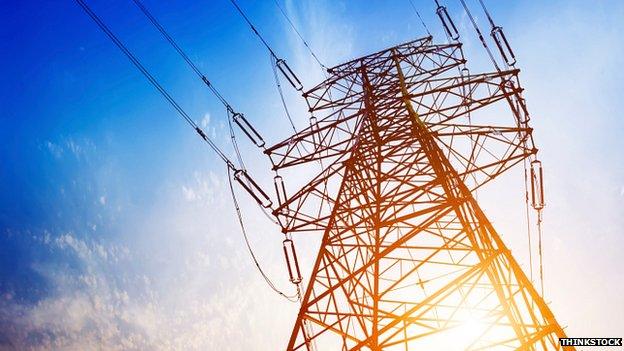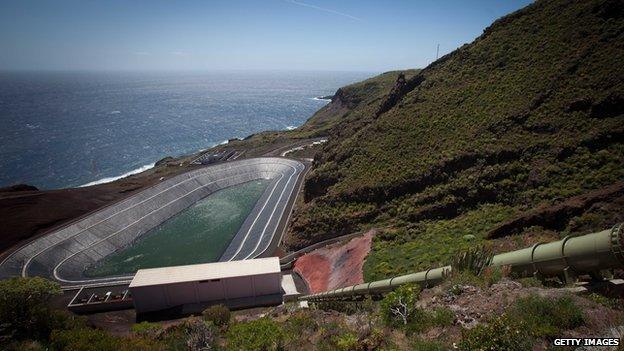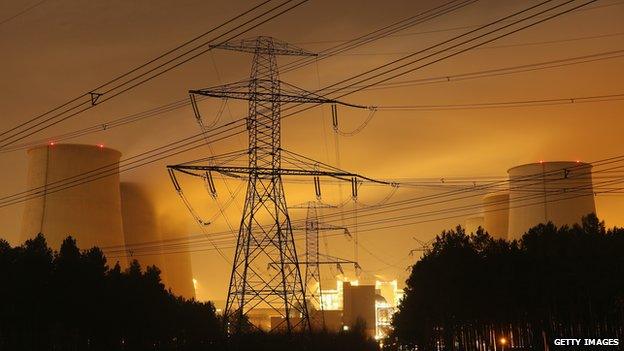Energy storage paves way for electricity independence
- Published

Demand for electricity from national grids would fall sharply with the widespread adoption of energy storage
Renewables have the power to transform not just the world's energy markets, but global economics and geopolitics.
But wind and solar alone cannot deliver a world of clean and free fuel. Both are, by their very nature, variable, so to realise their true potential other technologies need to be harnessed.
Improving connectivity to other countries is one relatively simple solution, but in a world where governments are becoming increasingly preoccupied with energy security, its attractions are somewhat limited.
Managing demand more effectively using smart grids and appliances is another.
But the technology with the most revolutionary potential is energy storage.
As Jimmy Aldridge at the UK's Institute of Public Policy Research think tank says: "This is the most exciting area within the energy sphere and it's totally transforming the way we interact with the grid."
'Huge disruption'
There are some very obvious ways in which storage can help communities and companies across the world.
Blackouts in developing economies can cause havoc.
In South Africa in 2008, for example, power cuts caused some of the country's biggest gold and platinum mines to close, leading to a rise in global commodity prices, not to mention huge disruption to the lives of millions. Such unreliable power grids also hamper foreign investment.

Power cuts are common in many parts of the world, particularly in developing countries
Energy storage can not only provide back-up power in case of power cuts, but also help electricity grids run at average rather than peak load, therefore reducing the chances of cuts in the first place.
To this end, Puerto Rico, for example, has set a 30% storage requirement for any new renewable capacity.

But it's not just developing countries that can benefit. The US government estimates that hundreds of power cuts between 2003 and 2012 cost the country up to $70bn (£45bn) a year. Tens of storage systems are already operating in many states, while California has set a target of 1.3GW to help meet its renewable objectives.
The UK has already built its first grid-level storage battery while Italy, Hungary and Saudi Arabia among others are likely to follow suit.
Storage is also proving invaluable for isolated communities that have no access to the national grid, with islanders in particular enjoying continuous power without the need for additional diesel generation.
Community power
But this is just the beginning. Renewables, together with energy storage, open the tantalising possibility of communities and individuals becoming energy self-sufficient.
With solar panels or wind turbines generating electricity and batteries storing it, households become far less reliant on the grid.
* Includes operational projects and those under construction Source: DOE Global Energy Storage Database
The costs today are prohibitively high for mass adoption, but there are already residential energy storage solutions on the market, such as those developed by the UK's Moixa Energy.
The German government is even setting aside €50m (£36m; $56m) a year to offer subsidies to its citizens specifically to help buy storage batteries. Since May 2013, some 5,500 Germans have been given on average €3,200, with demand increasing all the time.
According to Julia Hertin at the German Advisory Council on the Environment, cost is still a barrier. "At the moment, this is more of an emotional decision than an economic one - people like the idea of being energy self-sufficient," she says.
"There could be a point when [storage] becomes a game changer, but we're not there yet."
But costs will come down. As Ben Warren at consultancy EY points out, solar panels cost 80% less than they did just five years ago.
"The storage market looks and smells just like the solar PV market did [then]," he says. "Over the next three to five years, energy storage will become very affordable, very quickly."
Indeed forecasts suggest the market could be worth anything between $30bn and $400bn in the next five to seven years.

The Spanish island of El Hierro is using hydro energy storage to become self-sufficient in renewable energy
The implications for consumers, big power utilities and grid operators are profound.
Small-scale storage could have a similar effect to grid-scale storage, as consumers would be able to buy power from the grid when it's cheap and plentiful, and use their own when it's more expensive. This would help balance demand and reduce strain on the system.
But it will also lead "very quickly to a point where demand from the grid is much reduced", says Mr Aldridge.
This raises important questions about who will pay for grid maintenance - initially at least only the more wealthy will be able to afford renewables and storage, leaving those who can't afford them to pick up the bill.
Electric transformation
But it's the utilities that will be hit hardest by a fundamental shift away from centralised energy production. As Andrew Jones at S&C Electric says: "You can't compete with someone who has no fuel costs."
Research by Barclays has estimated that 20% of US electricity consumers will be able to use power from solar and storage for the same price as they get it from the grid by as early as 2018.
It concluded: "In the 100-year plus history of the electric utility industry, there has never before been a truly cost-competitive substitute available for grid power.
"We believe that solar plus storage could reconfigure the organisation and regulation of the electric power business over the coming decade."

Demand for central power generation and distribution will fall with the take up of energy storage, experts say
As a result, the bank downgraded its credit rating on all US electricity utilities.
The threat is so grave, in fact, Citibank has estimated that "in their current form" utilities in developed economies could see the size of their market shrink by more than 50%.
The point is not lost on some. At the end of last year, the boss of German energy giant E.On announced the company was spinning off its fossil fuel and nuclear business to focus on renewables, declaring that the traditional business model for utilities had "broken apart".
As Mr Warren says, with an increasing number of energy services companies able to provide everything their customers need to generate and store their own energy, utilities are waking up to the fact that "central generation and pumping juice down wires is not the future".
The ultimate beneficiaries, of course, will be consumers.
Energy storage paves the way for what Bill Watkins at Imergy Power Systems calls the "democratisation of energy", where consumers are no longer in thrall to big power companies and are able to generate their own power that, after set-up costs, is effectively free.
Large-scale generation and national grids are not going to disappear overnight, if ever, but many individuals and communities will soon have the power to choose their own energy futures.
Some within the industry view such a bold vision with scepticism. They do so at their peril.